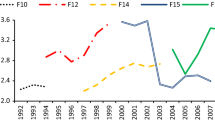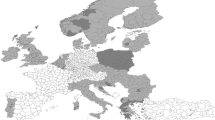Abstract
We propose an estimation methodology of per-capita incomes using satellite information on night luminosity (DMSP-OLS Nighttime Lights Time Series), using a structure of continuous spatial random effects and correction for measurement errors. This methodology allows the construction of income measures for disaggregated units and also building income estimates for years without census information. We apply this methodology using information for the Brazilian territory, and the results indicate that inclusion of spatial random effects is critical to the accuracy of the estimated income, and that these spatial effects are persistent in time.

























Similar content being viewed by others
References
Agnew, J., Gillespie, T., Gonzales, J., & Min, B. (2008). Baghdad nights: Evaluating the us military ‘surge’ using nighttime light signatures. Environment and Planning, 40, 2285–2295.
Amaral, S., Monteiro, A. M. V., Câmara, G., & Quintanilha, J. A. (2006). DMSP/OLS night-time light imagery for urban population estimates in the Brazilian Amazon. International Journal of Remote Sensing, 5(10), 855–870.
Arbia, G. (2006). Spatial econometrics—Statistical foundations and applications to regional convergence. Berlin: Springer.
Bivand, R. S., Pebesma, E., & Gomes-Rubio, V. (2013). Applied spatial data analysis with R. Berlin: Springer.
Brenner, S. C., & Scott, R. (2007). The mathematical theory of finite element methods. Berlin: Springer.
Cameletti, M., Lindgren, F., Simpson, D., & Rue, H. (2013). Spatio-temporal modeling of particulate matter concentration through the spde approach. AStA Advances in Statistical Analysis, 97, 109–131.
Cauwels, P., Pestalozzi, N., & Sornette, D. (2014). Dynamic and spatial distibution of global nighttime lights. EPJ Data Science, 3, 1–26.
Chen, X. (2015). Explaining infant mortality and poverty rates: What we can learn from night-time lights? Spatial Demography, 3, 27–53.
Chen, X., & Nordhaus, W. (2011). Using luminosity data as proxy for economic statistics. Procedings of National Academy of Sciences, 108(21), 8589–8594.
Doll, C. N., Muller, J.-P., & Morley, J. G. (2006). Mapping regional economic activity from night-time light satellite imagery. Ecological Economics, 57, 75–92.
Elvidge, C. K., Baugh, E., Kihn, E., Kroehl, H., & Davis, E. (1997). Mapping of city lights using dmsp operational linescan system data. Photogrammetric Engineering and Remote Sensing, 63, 727–734.
Elvidge, C. D., Sutton, P. C., Ghosh, T., Tuttle, B. T., Baugh, K. E., Bhaduri, B., et al. (2009). A global poverty map derived from satellite data. Computer and Geosciences, 35(8), 1652–1660.
Henderson, J. V., Storeygard, A., & Weil, D. N. (2012). Measuring economic growth from outer space. American Economic Review, 102(2), 994–1028.
Imhoff, M., Lawrence, W., Stutzer, D., & C.D., Elvidge. (1997). A technique for using composite DMSP/OLS city lights satellite data to map urban areas. Remote Sensing of Environment, 61(4), 361–370.
Lindgren, F., Rue, H., & Lindstrom, J. (2011). An explicit link between Gaussian fields and Gaussian Markov random fields: The stochastic partial differential equation approach. Journal of the Royal Statistical Society, Series B, 73(4), 423–498.
Muff, S., Held, L., Riebler, A., Rue, H., & Saner, P. (2015). Bayesian analysis of measurement error models using integrated nested Laplace approximations. Journal of Royal Statistical Association, Series C, 64(2), 231–252.
Nordhaus, W., & Chen, X. (2014). A sharper image: Estimates of the precision of nighttime lights as a proxy for economic statistics. Journal of Economic Geography, 15, 1–30.
R Core Team. (2015). R: A language and environment for statistical computing. Vienna, Austria: R Foundation for Statistical Computing.
Rozanov, J. A. (1977). Markov random fields and stochastic partial differential equations. Mathematics of the URSS Sbornik, 32, 515–534.
Rue, H., & Held, L. (2005). Gaussian Markov random fields: Theory and applications. London: Chapman & Hall.
Rue, H., Martino, S., & Chopin, N. (2009). Approximated Bayesian inference for latent Gaussian models by using integrated nested Laplace approximations (with discussion). Journal of the Royal Statistical Society Series B, 71, 319–392.
Simpson, D., Lindgren, F., & Rue, H. (2012). Think continuous: Markovian Gaussian models in spatial statistics. Spatial Statistics, 1, 16–29.
Whittle, P. (1954). On stationary processes on the plane. Biometrika, 41(7), 434–449.
Zhuo, L., Ichinose, T., Zheng, J., Chen, J., Shi, P. J., & Li, X. (2009). Modelling the population density of china at the pixel level based on DMSP/OLS non-radiance-calibrated nightime light images. International Journal of Remote Sensing, 30(4), 1003–1018.
Acknowledgments
I thank the valuable comments received from two anonymous referees and the editor Jeremy Porter. I appreciate the support of CNPq and FAPESP. The analysis of this work were performed using the R software (R Core Team 2015), using the INLA, sp, raster, rasterVis, maptools, rgeos, dismo and rgdal packages, and Fig. 3 was created by the GRASS GIS software.
Author information
Authors and Affiliations
Corresponding author
Rights and permissions
About this article
Cite this article
Laurini, M.P. Income Estimation Using Night Luminosity: A Continuous Spatial Model. Spat Demogr 4, 83–115 (2016). https://doi.org/10.1007/s40980-016-0018-4
Published:
Issue Date:
DOI: https://doi.org/10.1007/s40980-016-0018-4




